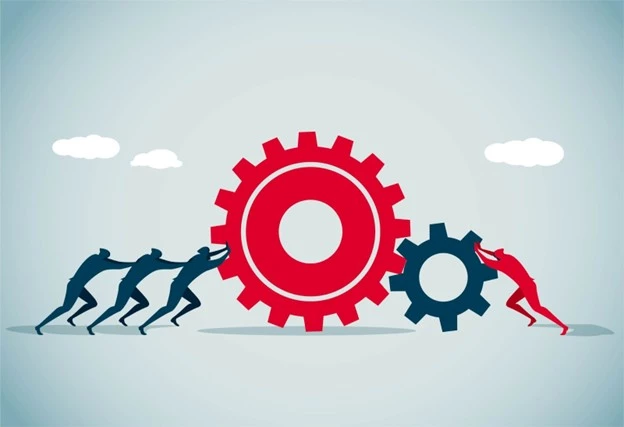“CEOs must take a new approach to succeed in 2021: One that requires understanding themselves, their teams, and their strategy – together.”
Pivoting was the priority for 2020, strategy will be the priority for 2021. While many organizations have been able to improvise in the face of unprecedented disruption, the amount and pace of change that leaders, middle managers, and teams have experienced has cost them their sense of organizational direction and clarity.
As the dust settles on the Pandemic, organizations are faced with essential questions about the nature and strategic direction of their business. For many, there is no going back to "normal" or even some sort of "new normal."
When unpredictable change is our defining reality, the only strategy that makes sense is a strategy to become adaptive.
Adaptive organizations are dynamic and agile, continuously interacting with and responding to their environments by understanding the things that affect organizational performance, operations, and resources. Examples include the impact of digitization, competition, etc. And now all that has changed due to the Pandemic. Now, add in well being, social justice, and virtual/remote work with all the implications since the Pandemic this year.
Setting strategy is not an event. It is a dynamic process that includes defining/affirming a clear and compelling long-term purpose or identity and setting the shorter-term strategic direction. Organizations must continuously understand their "unique competitive advantage'' and "do things differently." (Michael Porter)
Furthermore, when the strategy becomes adaptive, it necessitates a different organizational design/structure, one where teams are the building blocks, and a major role of leadership is creating conditions for those teams to flourish.
Teams and Adaptable Design
Teaming is a core element of strategy and a design component of adaptive organizations. Teams are where the work of an organization REALLY gets done, so it follows that strategy ultimately must be co-created with teams. Organizations, even small to medium size, can be complex, and therefore the old ways of working are no longer sufficient.
Teams are also basic building blocks of organizations, and as such, they naturally form and reform to meet the needs of the workflow. Unlike traditional top-down organizations where a controlling hierarchy creates structures designed to control and constrict, adaptive organizations thrive through self-organizing hierarchies (teams) that arise as needed to enhance flow - of ideas, information, materials, and resources - and reduce the frictions (i.e., silo's, etc.) that impede flow.
Today the definition of Teaming often has expanded from "Intact Teams" to "Teams of Teams" and team membership include may also include suppliers, customers, and other stakeholders - as organizations and their ecosystems are increasingly volatile, uncertain, complex, ambiguous.
A team approach necessitates that employees are oriented around a common problem vs. individual roles and responsibilities. Teams must be fluid and "open with distributed but coordinated accountability and decision making" - meaning everyone at some point works outside of their role to get the job done.
Features of Traditional Team Design:
The decision to form a team often comes from outside the team - a need is identified, a team is formed and given the authority to address that need.
- The team (and its members) is static, rigid, and fixed
- The team is primarily defined by its function and responsibility
- A few people in leadership roles manage the vast majority of the teams
- Individuals succeed by mastering a skill and repeating it
Features of Team-of-Teams Design:
The team is primarily defined by an objective that is bigger than any team could achieve single-handedly
- The team is evolving and fluid; members come and go as the nature of the problem changes
- There is very little hierarchy; leadership, decision-making, and execution are decentralized but coordinated among team members
- Team members succeed by taking agency to enable change in any context. Successful team members are change makers
Conditions for Effective Teaming (and Self-Organization) Include:
- Simple rules: i.e., a clear and inspiring purpose (identity) for an organization, clear strategy based on that purpose
- Strategic understanding and buy-in
- Freedom to experiment; tolerance for some disorder - experimentation fostering new structures, designs, ways of thinking & doing
- Networks support connections
- Shared leadership, distributed decision making
An analogy of real teaming in nature is a school of fish; they react to changes in their environment in highly synchronized and responsive constellations. Fish shoal, swim together, and school, swim in a coordinated fashion. In this analogy, scientists have learned that this is genetic and instinctual in fish; however, they have not yet proven the same in humans. In humans and organizations, conditions need to be created to allow for this synchronicity.
Leadership
Since the beginning of the Covid-19 Pandemic, teams have encountered more complexity given the extent of remote work. 51% of CEOs cite remote teaming as a top challenge ("CEO Benchmarking Report 2021" by The Predictive Index), with many executives doubting their teams' ability to hit their strategic goals. While executives cite people issues as part of the problem (i.e., interpersonal conflict, lack of connection/team cohesion, communication, well-being issues), we argue that most organizations have not created the conditions for their teams' success. Creating those conditions is the primary role of leadership. When teams thrive, so does the organization.
In adaptive organizations, the role of leadership is twofold: (Stephan Haekal Adaptive Enterprise)
- Create, communicate, and enforce an unambiguous organizational context that ensures employee alignment while enabling self-organization - a key attribute of teaming.
- Develop a system of coordination to "govern – but not dictate – individual's behaviors to ensure they are consistent with the organizational context."
Organizational Context contains three basic components: the organization's reason for being (purpose), its governing principles, and its high-level business design. Collectively, these elements create a context that informs accountable, empowered people "where the organization is headed, the boundaries on their actions, and a picture of how what they do relates to what others do and to the organizational purpose." Clear context creates an unambiguous and unifying framework for individual and group activity that supports self-management.
A System of Coordination ensures that organizational behavior accords with the context. To do this requires tracking commitments negotiated among accountable, empowered people rather than activities. In a sense-and-respond organization, commitments that define organizational roles, emphasizing the interaction of system elements, not on their actions—coordinating commitments, rather than supervising activities, is the proper leadership concerns.
In the example below: a leader's role moves from command and control of individuals and teams to an organizational system of teams designed and governed by Organizational Context and a System of Coordination. This requires a "fundamentally different organization design." (strategy to structure to management processes, to people processes to metrics & rewards)
Strategy from now on must be co-created with teams for an organization to be adaptive.
No longer is the strategy determined by the executive team alone. Information about the organization's marketplace, customers, suppliers’ ecosystems resides deeper within the organization and externally. Adaptive organizations utilize information from all parts of the organization to thrive.
Conclusion
This continually changing world calls for new and adaptive forms of organizations that facilitate and promote workflow and collaboration dynamics. Teaming, including teams of teams, now more than ever, is included as a central strategy.
Creating adaptive organizations, teaming organizations means that your organization will not only survive but thrive in the new world. And perhaps even more importantly, be poised to influence your industry, your community, your country.
We urge YOU, YOUR Teams, and YOUR Organization to take this opportunity to reimagine yourselves. In our November 12th Blog- we presented a case for change. We strongly urge you to not consider going back "to normal" or even "a new normal". We are all well beyond normal.
Warmly,
Lori, Sally and James
Supporting business leaders and HR/OD Leaders to transform cultures and transition through the Pandemic and beyond.
Lori Heffelfinger, MSOD, PCC & James Jackman, MSOD
———
Sally B. Parker
sally.bparker@timezeroenterprises.com

References:
- "Your Team Never Mattered So Much" by Ashoka, Forbes, 12 05 2015.
- "Key takeaways from Team of Teams by General Stanley McChrystal" by Beau Gordon, Mar 27, 2017.
- "Organization as Living Organism and Complex Adaptive System" byJaakko Hartikainen & Mikko Virtanen, June 28, 2019.
- "CEO Benchmarking Report 2021" by The Predictive Index, 2021.
- "Leveraging the Power of Disruption: To Reimagine Your Organization" by Lori Heffelfinger, Sally B. Parker, and James Jackman, November 12, 2020.
- "Adaptive Enterprise: Creating and Leading Sense-And-Respond Organizations" by Stephan H. Haeckel, Harvard Business School Press, 1999.
- "Who Do We Choose To Be?: Facing Reality, Claiming Leadership, Restoring Sanity" by Margaret J. Wheatley, Berrett-Koehler Publishers, Inc., 2017.
- "The Agility Factor: Building Adaptable Organizations for Superior Performance" by Christopher G. Worley, Thomas Williams, and Edward E. Lawler III, Jossey-Bass, 2014.
- “Strategy: Creating and Sustaining Competitive Advantage”By Professor Michael Porter, Harvard Business School. WOBI Strategy Series, November 2020.







